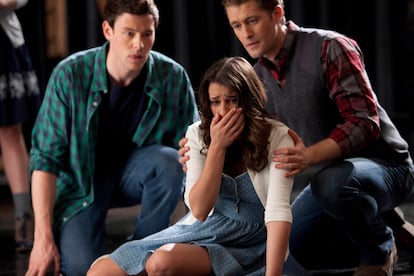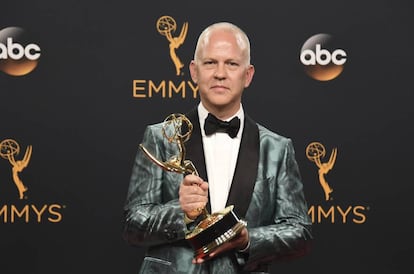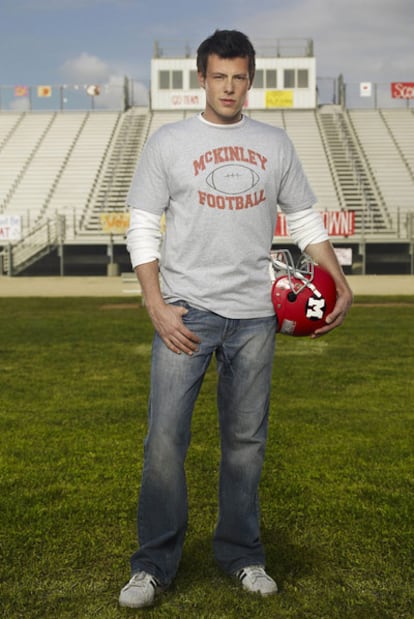Death, drugs and abuse in ‘Glee’, the series that shaped an entire generation
A new documentary called ‘The Price of Glee’ delves into the on- and off-screen action of the iconic musical series that became marred by tragedy

“In May 2009, 10 young actors made their television debut on Glee. By 2020, all of them would be famous, and three of them would be dead.” This is how the trailer kicks off for The Price of Glee, a docuseries that Discovery+ will premiere in the United States on January 15. Over the course of three episodes, it aims to unravel “the dark side of the series both on-screen and off.” The show’s protagonists have reacted angrily to the documentary. Chord Overstreet, who played Sam Evans, has called it “bullshit.” Kevin McHale (Artie), who shares a podcast about the ins and outs of the series with his partner in Glee, Jenna Ushkowitz (Tina), has also been very critical on social media, describing the documentary as “trash.”
Since the show wrapped in 2015, there have been multiple altercations among its main characters. Most notably, Lea Michele (Rachel Berry) has been accused of racism and bullying by several of her co-stars. Her rivalry with Naya Rivera (Santana Lopez) was such that Glee’s creator, Ryan Murphy, joked that it had inspired his subsequent series, Feud, which examines the conflict between Bette Davis and Joan Crawford during the filming of What Ever Happened to Baby Jane (1962). Michele is now on Broadway as Fanny Brice in Funny Girl, a role she knows well – her rendition of Don’t Rain on My Parade was one of the more memorable moments for her character in Glee.
Whatever took place on and off the set of Glee, the actors’ response to the documentary is what happens on Glee, stays on Glee. “It doesn’t matter what happened on that set,” Becca Tobin said on the Everything Iconic With Danny Pellegrino podcast. “At the end of the day, it’s a family. It’s like a big dysfunctional family and there is a loyalty there.” The actress, who played the evil cheerleader Kitty Wilde and joined the series in the fourth season, also talked about the insistence deployed in trying to persuade her and other Glee stars to take part in the docuseries. “There’s somebody out there who’s trying desperately to put together a documentary, or a tell-all or something or other, who keeps contacting us relentlessly,” she said.

Meanwhile, the documentary’s makers are trying to justify the project, which is backed by the producers of House of Hammer, which centered on the family of the disgraced actor Armie Hammer. Jason Sarlanis, Discovery’s head of crime and investigative content, has released a statement about the motivation behind it, saying: “While celebrating the show’s indelible mark on pop culture and its unprecedented success, The Price of Glee takes a hard look at the intense pressure that results from being catapulted into superstardom and sheds new light on the terrible tragedies that befell the cast and crew of Glee.”
A show that follows the lives of the members of the William McKinley High School choir, Glee aired on Fox in 2009 with few expectations. The show’s creator, Ryan Murphy, was not yet known as the producer of such successful series as American Horror Story (2011), Feud or Dahmer – Monster: the Jeffrey Dahmer Story (2022). He had produced Nip/Tuck (2003-10), a disturbing fiction about plastic surgeons, and Popular (1999), a teen comedy that paved the way for Glee.
But it didn’t take long for Glee to become a phenomenon. Along with American Idol, it drew in over 10 million viewers each week. It won a Golden Globe in its first season and spawned multiple spin-offs and successful tours that led to million-dollar sales of all the show’s albums. Its famous mashups and its carefully choreographed songs were weekly events and many topped the charts. Artists fought to try and get their songs on a series that shot Journey’s 1981 song Don’t Stop Believin’, to number one.
Glee became the kind of show the world’s biggest music stars wanted to be a part of. Joining the cast for guest appearances were Britney Spears, Olivia Newton-John, Whoopi Goldberg, Sarah Jessica Parker and Gwyneth Paltrow, who met her current husband, Glee producer Brad Falchuk, on the set. There were also members of Broadway royalty, from Idina Menzel to Patty Lupone, muscling in on the act. Over the course of its six seasons, Glee was like an edgy version of Disney’s High School Musical (2006). Its humor was blunt. In the first episode, the choir teacher blackmails Finn by placing marijuana in his locker; a few episodes later his wife gives the students pseudoephedrine to energize their performance.
The characters were stereotypes: the dim-witted quarterback, the perfectionist, the gay man obsessed with musicals and the Black woman with a strong personality, but not quite strong enough to overshadow the white leading lady. “I’m Beyoncé, not Kelly Rowland,” protested Mercedes Jones in the pilot. She embraced the parody so wholeheartedly that Mike Chang, the character played by Harry Shum Jr, now starring in Grey’s Anatomy, was often referred to simply as “the other Asian.” The swearing came predominantly from Sue Sylvester, who was played by Jane Lynch, frequently nominated for awards during the early years of the series.
But the truth is that Glee gave airtime to the kind of characters not often seen on TV back in 2009. Nowadays, we celebrate series such as Bros, considered the first mainstream gay comedy, but more than a decade ago Glee was already depicting Kurt and Blaine’s teenage romance on primetime and also that of cheerleaders Brittany and Santana, who ended up getting married. The show evolved to include gender-fluid characters, played by gender-fluid actors, and its raw exposure of the effects of homophobia and bullying couldn’t fail to have an impact. It also dealt with the issues of teenage pregnancy, high school shootings and addiction. All this on Fox, a conservative national network. Nevertheless, Glee generated its share of controversy even among the woke. For example, the choice of Kevin McHale, an actor without mobility issues, to play a wheelchair-bound character, was widely criticized. “Knowing what we know now, I don’t think I should be playing a character that’s in a wheelchair,” the actor acknowledged when speaking about whether he would consider being in a Glee reboot.

The ‘Glee’ curse
The death of Cory Monteith scarred the show. His character, Finn Hudson, was its mainstay; a sensitive quarterback with a prodigious voice who radiated charisma. Cory was in a relationship both on- and off-screen with Lea Michele that kept the audience glued. He was living a perfect moment and his future in Hollywood seemed assured. But on July 13, 2013, his body was found at the Fairmont Pacific Rim Hotel in Vancouver. The cause of death was an overdose of heroin combined with alcohol. He was 31. Three months later, the series paid tribute to him in the harrowing episode, The Quarterback. “If I had to do it over again, we would have stopped production for much longer and we might not have come back,” Murphy confessed years later. A few days ago, he repeated the sentiment on McHale and Ushkowitz’s podcast: “I’ve thought a lot about that recently and I would not have done that [episode] now. I felt like it was way too raw and way too soon. You can’t really recover from something like that.” Finn had played a central role when the show kicked off, and he was to do so in the finale as well. Murphy explained that the idea was to have Rachel triumphantly returning to a high school where Finn was a teacher. “I’m coming home,” she would tell him. The end. But it was not to be.
A second tragedy struck in 2015 when the Los Angeles police arrested Mark Salling, Glee’s Puck, a badass with a sensitive side and a Mohican who was Finn’s best friend. On his personal computer they found more than 50,000 images of child pornography. He pleaded guilty to the charges and was sentenced to between four and seven years in prison. But before he could be put behind bars, he hung himself in a forest near his home.
Five years later, in 2020, Naya Rivera, who played the entertainer Santana Lopez, had an accident while sailing on Lake Pinu with her four-year-old son. Missing for days, all kinds of theories were mooted until finally it was established that she had drowned after saving her son’s life. A fresh blow to cast and crew.
But there was more to come. Becca Tobin’s boyfriend, nightclub owner Matt Bendick, was found dead in a Philadelphia hotel after suffering a heart attack, thought to have been triggered by stress. He was 35. In 2019, Melissa Benoist released a heartbreaking video in which she spoke of the abuse she had suffered at the hands of her husband Blake Jenner. Both had come to Glee in the fourth season to replace Rachel and Finn and, like their predecessors, had fallen in love on set. Jenner accepted responsibility but hit back by blaming the Supergirl star for damaging his career due to unhealthy jealousy.
The latest scandal emerged from the teachers’ quarters. After just one week in the role of judge on the dance show So You Think You Can Dance, Matthew Morrison, Spanish teacher Will Schuester, was fired outright after one of the contestants accused him of sending her “inappropriate” messages. Speculation resurfaced about Glee’s curse.
Murphy has blamed many of the controversies and incidents on the cast’s age: “How are you going to behave at 18 or 19 if you become a global star overnight?” he said. But he also touched upon a possible seventh season: “Should we reboot it in some way?” he mused. Ushkowitz was delighted: “If Ryan was involved, I mean, that’s when you consider it. That’s when you talk about actually the possibility of doing it.” But she wasn’t as positive about the documentary: “I don’t have anything good to say about it, so I’m not going to say anything at all,” she said.
Sign up for our weekly newsletter to get more English-language news coverage from EL PAÍS USA Edition
Tu suscripción se está usando en otro dispositivo
¿Quieres añadir otro usuario a tu suscripción?
Si continúas leyendo en este dispositivo, no se podrá leer en el otro.
FlechaTu suscripción se está usando en otro dispositivo y solo puedes acceder a EL PAÍS desde un dispositivo a la vez.
Si quieres compartir tu cuenta, cambia tu suscripción a la modalidad Premium, así podrás añadir otro usuario. Cada uno accederá con su propia cuenta de email, lo que os permitirá personalizar vuestra experiencia en EL PAÍS.
¿Tienes una suscripción de empresa? Accede aquí para contratar más cuentas.
En el caso de no saber quién está usando tu cuenta, te recomendamos cambiar tu contraseña aquí.
Si decides continuar compartiendo tu cuenta, este mensaje se mostrará en tu dispositivo y en el de la otra persona que está usando tu cuenta de forma indefinida, afectando a tu experiencia de lectura. Puedes consultar aquí los términos y condiciones de la suscripción digital.
More information
Archived In
Últimas noticias
Most viewed
- Oona Chaplin: ‘I told James Cameron that I was living in a treehouse and starting a permaculture project with a friend’
- Reinhard Genzel, Nobel laureate in physics: ‘One-minute videos will never give you the truth’
- Sinaloa Cartel war is taking its toll on Los Chapitos
- Why the price of coffee has skyrocketed: from Brazilian plantations to specialty coffee houses
- Silver prices are going crazy: This is what’s fueling the rally











































